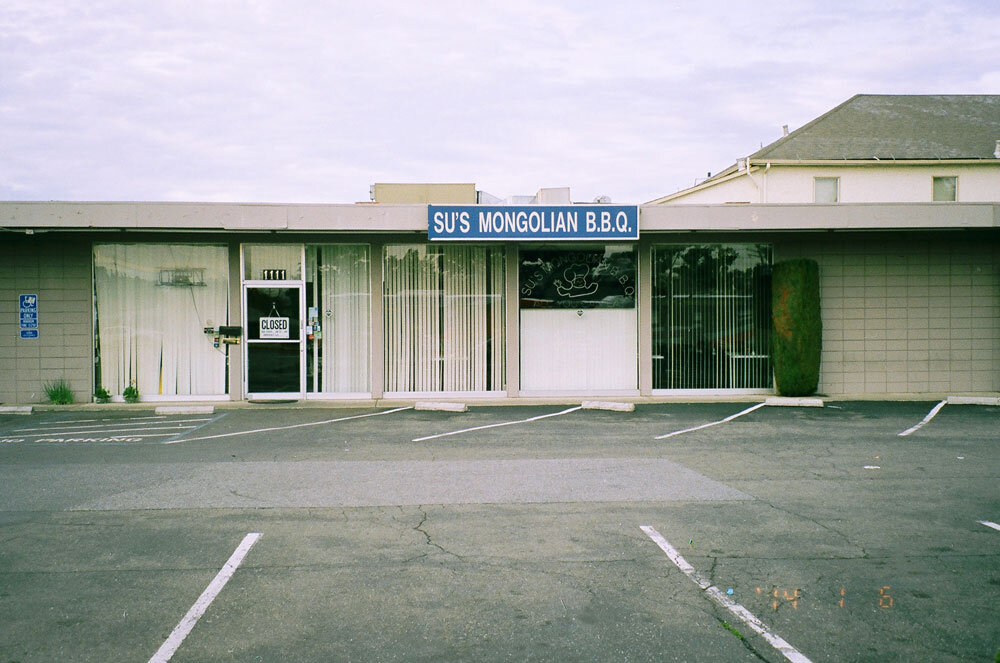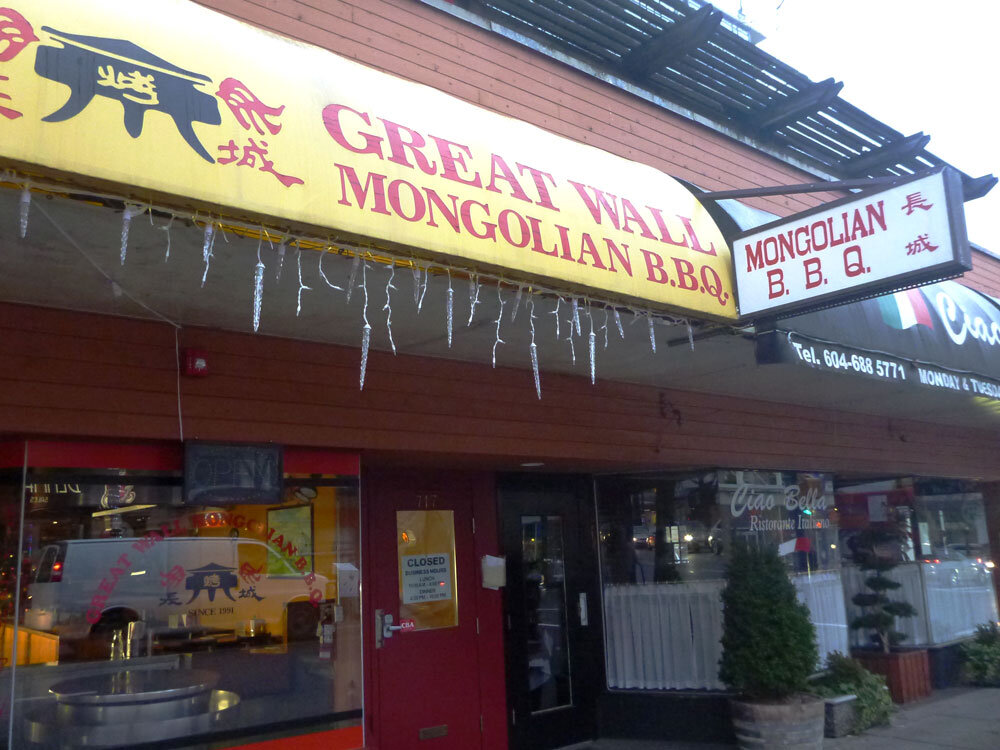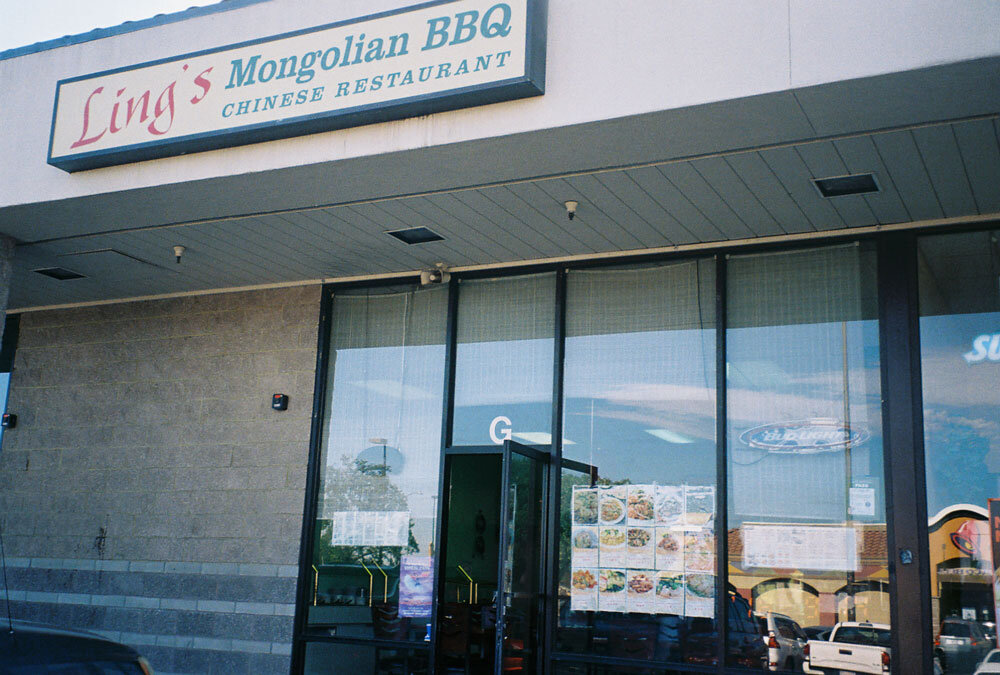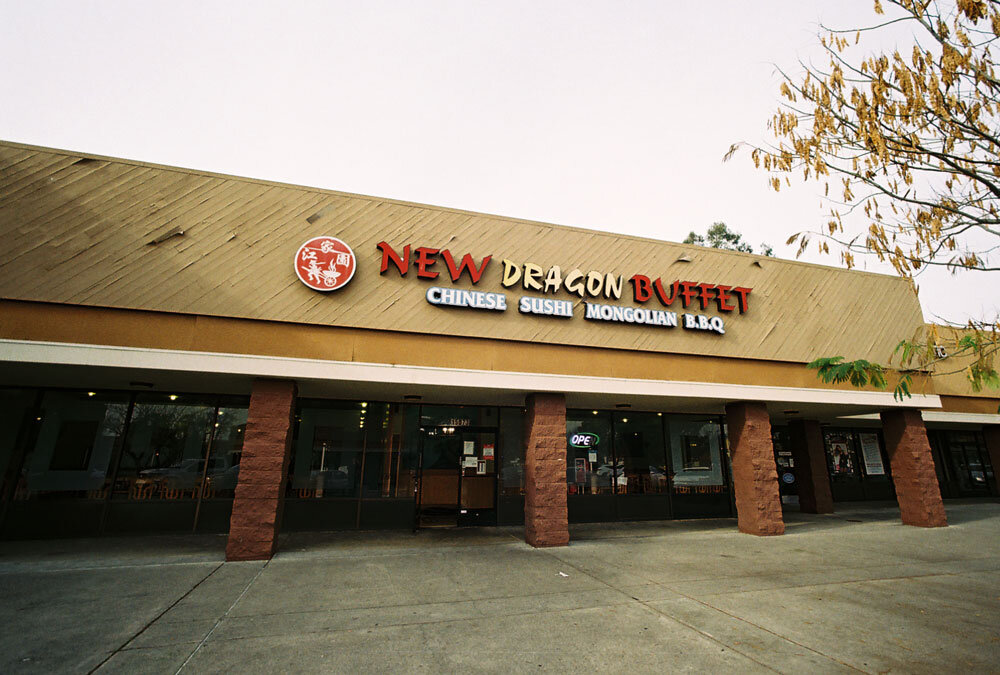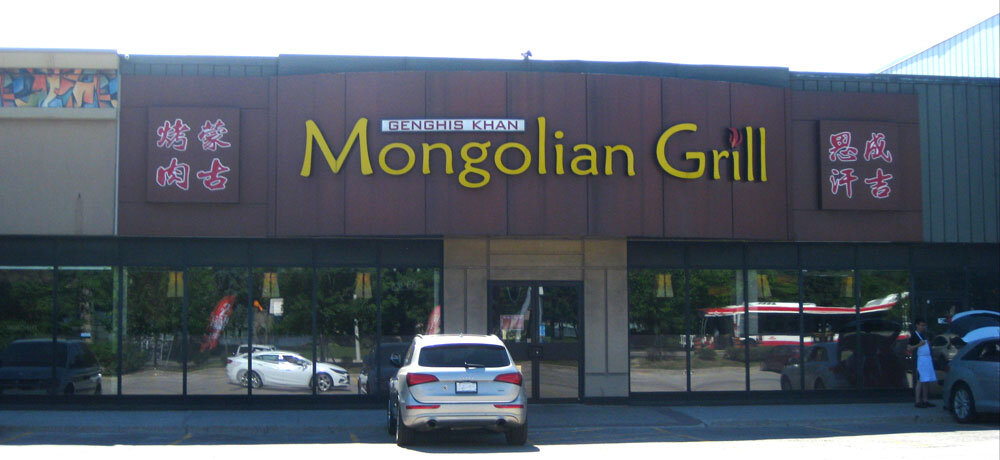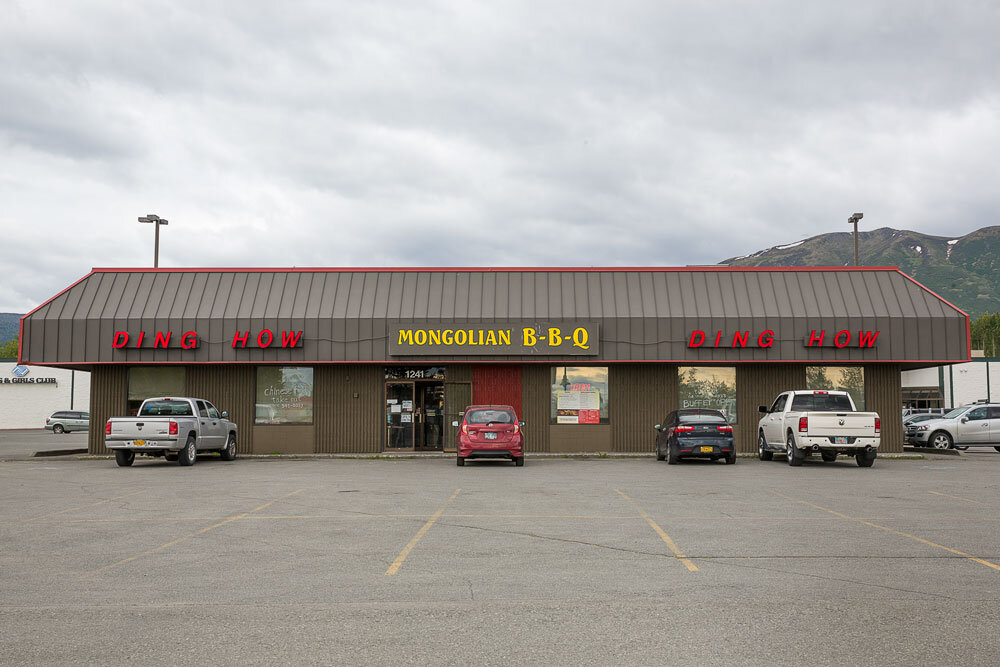Mongolian Barbecue on the Banks of Grass Creek

Consider the experience of eating Mongolian barbecue, not as an abstract proposition but in one particular place: Ding How Mongolian B-B-Q in Anchorage, Alaska.
If you think of Alaska as a wilderness of snow, the presence of such a restaurant here might seem surprising. It’s true that the restaurant sits on a low bluff above an ancient salmon stream called Chanshtnu, which means “Grass Creek” in the language of the indigenous Athabaskan people who have fished its waters since time immemorial; and also true that steep and snow-capped mountains dominate the eastern horizon behind it. But the immediate setting is decidedly un-pastoral: on the west end of a large parking lot, squeezed between Samurai Sushi and a Taco Bell, verging a major urban artery lined with second-run movie theaters, smoke shops, and trailer parks. In the lot, coated with the film of silt and exhaust pervasive in the north country after the snow melts, a tall green billboard advertises “Ding How Chinese/Mongolian B-B-Q/All You Can Eat” with a kitschy bamboo font and a thumbs-up icon. The building itself is long, drab, and low-slung, typical of the aggressively utilitarian, wood-paneled architecture that sprouted up all over town during an oil boom here in the late 1960s and early 1970s.
As you go through the door, prominently marked with a “God Bless America” decal, the grime of urban East Anchorage cedes to a brightly-lit, shinily clean interior, with decor that crosses the bridge from spare to sterile. Although the few paintings on the walls are Chinese, the replica of the Divine Bell of King Seongdeok next to the cash register and the Hangul calendar behind it are clues that this establishment is owned by neither Mongolians nor Chinese, but Koreans. The proprietor, a middle-aged woman of small frame and austere appearance – sensible black flats and an olive-drab apron with a multitude of pockets – is a hands-on owner, moving energetically about the restaurant: here checking the temperature of the soft-serve ice-cream machine or replenishing the rice-pot, there running a card at the register or guiding a large Samoan family to their table.
Directly across from Mrs. Lee’s register stands a long cold-food table, behind which is a large, round iron griddle heated from underneath by a propane stove; together, these comprehend the Mongolian barbecue apparatus. Perpendicular to the cold food table is a Western-style salad bar and a hot buffet, with basins full of sweet-and-sour-pork, a dish labeled “T-General Chicken,” and other staples of American-Chinese buffets such as lo mein and brownies.
If you go the Mongolian barbecue route, you’ll first come to bins of thinly-sliced, slightly frozen meat: pork, chicken, and beef. Next, there’s a bin of northern Chinese-style wheat noodles, and then a wide variety of vegetables: wosun, celery, bai cai, green peppers, onions, carrots, mushrooms, and that overseas-Chinese-food standard, pineapple. You’ll ladle as much of each ingredient as you like into a heavy wooden bowl, then slide down the line to the saucing station. The chef, Matteo, a cheerful immigrant from Mexico wearing a tall toque and a crucifix, will ladle combinations of eight liquid ingredients (soy sauce, wine, ginger sauce, sweet sauce, garlic sauce, oyster sauce, BBQ Oil, and hot oil) into your bowl in various proportions to make one of four sauce styles: Cantonese, Mongolian, Teriyaki, or Szechwan. The components and proportions of the sauces are explained in a plastic-encased sign: Cantonese-style, for instance, contains no garlic sauce, while Szechwan has a spoonful and a half of it. Matteo will take your freshly-sauced ingredients and dump them onto the griddle. He’ll push them around theatrically using long cooking chopsticks, periodically turning to ensure even cooking. Everything will sizzle dramatically as it defrosts and heats. Once the meat is cooked and the show complete, he’ll scoop the ingredients back into your bowl with a flourish and you’ll take it, steaming, back to your seat, where you can consume it at leisure along with your T-General Chicken and your brownies.
If you’ve never had Mongolian barbecue before, all of this might seem utterly baffling, a cascade of culinary conundrums, starting with the presence of a Chinese restaurant (let alone a Taco Bell or a second-run movie theater) in Alaska – and not just a Chinese restaurant but one that is simultaneously Chinese and Mongolian, and the latter despite the general cultural invisibility of Mongolians in America.1 This in turn raises the question of why either kind of cuisine is being produced by Mexicans in a restaurant owned by Koreans, and also foregrounds the fact that the food can in no way be mistaken for barbecue.
On the other hand, if you’ve been inside a “Mongolian BBQ” in a place like West Des Moines or Albuquerque, Ding How will seem entirely representative of its breed: a particular kind of Chinese-American restaurant as familiar on the urban landscape as a red robin (or a Red Robin). If you are also broadly aware that Anchorage is a Pacific coast city of 350,000 souls and nearly all the trappings of modern life, then the whole thing may actually seem entirely unremarkable: a Chinese all-you-can-eat in a low-income American neighborhood. In either case, remarkable or not, eating Mongolian barbecue on the banks of Grass Creek is an apt metaphor for explaining how this kind of restaurant came to be in this place: Instead of pineapple and pork and oyster sauce, it’s Japanese colonial ambitions thrown together with a refugee’s nostalgia for the lost city of his youth, marinated in the currents of trans-Pacific trade and migration, heated by the fires of war and revolution, all coming to rest in the wooden bowl of this subarctic city by the sea.
If you divest yourself of any sense of the familiar and allow yourself to marvel at the strangeness of it all, the story of Mongolian barbecue – how it came to be, and how it came to be in Anchorage – reveals itself as the story of the whole Pacific Rim in the 20th century, a turbulent history that birthed new cities like volcanoes rising from the sea, and bore migrant peoples and the foodways they carried from one aborning city to another.
To understand how Mongolian barbecue came to Anchorage, you’d want to start (so you’d think) in Mongolia. Mongols made so vivid an impression during their brief domination of the Old World that the mere mention of the name immediately conjures a precise image: wind rustling steppe-grass, befalconed rider astride mare, and so forth. Picture the warrior, making camp after a long day in the saddle, ginning up a meal by cooking thin-sliced meat and vegetables in his crested helmet, and you have, according to lore, the origin of Mongolian barbecue. One problem with this story is that it is obvious bullshit: Where would Mongols on the hoof get hot cooking oil? And if they had it, why would they pour it into the helmets they’d been wearing all day and would wear again tomorrow?
“Mongolian barbecue” bears little resemblance to actual Mongolian cuisine, which is long on yogurt and barley and short on oyster sauce and pineapple. Its origins are entirely unmysterious: It debuted in Taipei in 1951. The cuisine is credited to Wu Zhaonan, a refugee from the mainland who later attained fame as a crosstalk comedian and immigrated to America in the 1970s. But it is not quite right to say that Wu Zhaonan invented the dish. What he invented was its showy preparation and its marketing as “Mongolian.” (The “folklore” about the Mongols cooking in their own helmets came later, a result of the foodway’s encounter with American consumer capitalism.) Yet the unromantic fact of Mongolian barbecue’s modern origins only raises more questions. If Mongolian barbecue is neither Mongolian nor barbecue, what is it actually, and why is it so called? Several possible answers present themselves, all bound up in the time and place of its creation and in the roots of its creator.
Photo by fintano (Flickr)
Taipei in 1951 was a city of refugees, thrust suddenly into the crucible of global conflict after some centuries as a colonial backwater of various masters. Eighty-one miles off the coast of Fujian, the island of Taiwan has been inhabited since time immemorial by indigenous people, sometimes called Formosans, who spoke languages related to Tagalog and Hawaiian. Han emigrants from Fujian arrived in the early 17th century, not long before Spanish and Portuguese colonies were built there. Not until the time of the Kangxi Emperor (who called the island “a ball of mud beyond the pale of civilization”) was Chinese sovereignty asserted and the city of Taipei established. Even then, it was scarcely less a colony than it had been under European domination, and the Emperor’s authority only extended over the island’s coast, with the hilly interior remaining the dominion of what the Chinese called “wild” Formosans.
When the Empire of Japan acquired Taiwan as its first overseas possession in 1895, they built a traditional colonial-extraction enterprise of sugarcane fields and pineapple plantations, but it was a remote outpost still, far removed from Japan’s grand ambitions in Manchuria, Korea, and mainland China. After Japan’s defeat in 1945, the island was returned to the Republic of China. Just four years later, it became the entirety of that country when Communists chased the Nationalist regime, and whatever allies and hangers-on could make it out, onto its island redoubt.
At the peak of this exodus as many as 4,000 people a day were pouring into Taiwan. By the time the dust settled in 1950, one-third of the island’s population were refugees from all parts of the mainland, mostly living in and around Taipei. On top of this mass migration came a smaller horde of Western diplomats and soldiers,2 as the city suddenly found itself of profound strategic importance in the Cold War – an island of free enterprise within range of Communist guns, like a tropical West Berlin.
Into this Cold War hot pot came Wu Zhaonan, a banker’s son and former economics student, reduced to running a food stall on the streets of a war-torn new city on an island far from home. He first named his stall “Fragrance of Barbecue” (烤肉香 kaorou xiang). Jiao Tong, the eminent Taiwanese food historian, vividly described the Tamsui District stall at the peak of its immense popularity:
Dignitaries, high-ranking officials, and foreign diplomats all dropped by to eat. At the riverbank was parked every kind of car. Diners walked along the stepping stones through the grass, enticed by the barbecue to eat under the moonlight. There was a dog named Harry (Hali) who, holding a lantern between his teeth, led diners to their tables.
As with so many refugees before and after, the food Wu Zhaonan made in the new land harkened back to his childhood home: 1930s Beijing, an ancient city on the old northern frontier, where camel caravans still gathered at the gates and yellow-robed lamas turned their prayer wheels – a city whose traditional foodways were much influenced by the folk from beyond the Great Wall, who for centuries had come into North China as conquerors, migrants, and tribute-bearers.
Photo by jbjelloid (Flickr)
Local foodlore enshrines the “three roasts of Beijing” (北京三烤 Beijing sankao): roast duck (烤鸭 kaoya), known to fame as Peking duck; roast sweet potato (烤红薯 kao hongshu), sold from barrel ovens on city streets in winter; and kaorou 烤肉, a phrase that translates literally as “roast meat” but also constitutes the “barbecue” part of “Mongolian barbecue” (蒙古烤肉 Menggu kaorou), which Wu Zhaonan soon renamed his establishment.
Beijing kaorou has existed as a street food since the 17th century – since before Taipei existed – and was traditionally associated with the city’s Hui Muslim population. The principal ingredient is lamb or beef, sliced thin, dipped in soy sauce, and cooked with slivered onions atop an apparatus called a zhizi 炙子, a round and slightly convex slatted metal grill pan heated from below by pine wood and cones, which imparted an essential fragrance to the food – a method of grilling meat over wood coals not unlike what Americans call “barbecuing.”3
The preparation and consumption of kaorou in Old Beijing was a vivid sensory experience. Nostalgic Beijingers would later recall the crackle and fragrance of smoldering pine embers, the glint of the sharp knives used for slicing, and the distinctive stance of the men who stood with the left leg propped on a bench while they turned the sizzling lamb on the zhizi, chewed on sesame biscuits, and washed it all down with hard spirits. This iconic Old Beijing scene, socially if not quite culinarily akin to the American backyard barbecue, must have loomed large in the childhood memories of Wu Zhaonan.
Photo by fintano (Flickr)
Mongolian barbecue may have been Beijing kaorou reborn in a new land, but the differences are as obvious as the similarities: it is more accurate to say that Wu Zhaonan reimagined rather than reconstituted the dish. Refugees and immigrants the world over bring with them recipes and memories of the old country, but they must also adapt to the realities of the new place, improvising with whatever ingredients and cookware are available. For Wu Zhaonan, Taiwanese ingredients represented an extension rather than a reduction of possibility. Displaced from the dusty North China plain, he expanded the lamb, onions, and soy sauce of Beijing kaorou into a riotously diverse tropical palette: chicken and pork; venison, a speciality of Taiwan’s interior highlands;4 lemon juice, chillis, pineapple.5 The more perplexing change, however, was in the cookware. Wu Zhaonan prepared his food not on a slatted grill pan awash in pine smoke, but on a solid, round griddle that conducted only heat, and not flavor, from a propane stove. Since one thing nearly every old Beijinger remembered about Beijing kaorou was the pine-smoked flavor, and since Wu Zhaonan himself alluded to it in the first name of his restaurant, this alteration demands explanation.
Jiao Tong wrote that Wu Zhaonan commissioned his first Mongolian barbecue griddle from a local metalsmith. Why did he not have them make a zhizi? One possible answer to this question may be that Wu Zhaonan was falling in on a food culture already in place on the island: not those of the indigenous Formosans nor those of the Fujianese migrants of the past few centuries; rather, those of their recently departed colonial overlords from Japan.
Photo by fintano (Flickr)
Consider the ingredients, impedimenta, and presentation of Mongolian barbecue: a variety of vegetables and meats chopped thinly, coated with oil, and heated and stirred right in front of you. You’d call it stir-fry if it was in a wok, but it’s on a solid, flat iron surface and much of the point is to observe the chef at work. To a first-order approximation, this is teppanyaki, the showy Japanese cuisine much beloved by suburban American kids who go to Benihana’s for their birthdays. Full-fledged teppanyaki did not emerge in Japan until after the end of World War II and thus could not have been the ancestor of Mongolian barbecue. Instead, this seems to be a case of parallel evolution brought about by the nearly simultaneous arrival, on Honshu and Taiwan, of a crucial ingredient: Westerners in huge numbers, consuming exotic “Oriental” cuisine as a sort of culinary performance art. But parallel evolution implies a common ancestor, which is that solid, flat iron surface: the tieban 鉄板. This apparatus, known in Japanese as a teppan (whence teppanyaki), has been part of Japanese home-cooking traditions for about 200 years and bears a much stronger resemblance to the Mongolian barbecue cooking surface than a zhizi. When Wu Zhaonan opened his food stall, Japan had been only five years gone from Taiwan. These occupiers had made a concerted effort to acculturate the native folk, both Formosans and Fujianese, into Japanese ways of education, of language, of food and drink. The teppan marked Japanese-ness the way a wok marks Chinese-ness and a barbecue grill American-ness – so perhaps the recently post-colonial artisans Wu Zhaonan commissioned made a teppan and not a zhizi because teppans were what they were accustomed to making.
There was, furthermore, a Japanese cuisine with an actual if tenuous connection to Mongolia, dating back to a World War I-era scheme to import sheep (previously known to Japanese only by reputation as an exotic beast herded by exotic Mongols) to their Home Islands to produce wool for global export. By the 1920s, the experiment had ended everywhere in Japan but Hokkaido, the northern island, where “Mongolian meat” became part of its regional cuisine. Restaurants served thin slices of vegetables and mutton with light oil, heated on grill resembling a Mongol helmet in form (convex) and substance (iron). This preparation, entirely Japanese in everything but the meat choice, was known as jingisukan (ジンギスカン, “Genghis Khan”) on Hokkaido. By the 1930s the dish had made its way to trendy restaurants in prewar Tokyo.
Could jingisukan have travelled from Tokyo to Taiwan before the war – another chapter in Japanese efforts to assimilate the Taiwanese – and thus providing a source for Wu’s new name for his stall? This is, admittedly, a roundabout conjecture for which there is no direct evidence. Furthermore, some of the similarities seem explicable by the distant common origins of jingisukan and Beijing kaorou as specimens of northeast Asian cuisine. For instance, the convex grill of the jingisukan does resemble a Mongolian helmet in form and substance, but it also resembles a zhizi; and the essential meat of both jingisukan and Beijing kaorou was mutton. Perhaps the truth is again like a bowl of Mongolian barbecue, an admixture of all the possibilities.
Photo by fintano (Flickr)
Whatever the true extent of Japanese influence on Mongolian barbecue, it would have been unpalatable to the new community of mainlanders in Taiwan, all loyal to at least some degree to the Nationalist regime which had spent the better part of a decade fighting Japan, to acknowledge any such influence openly. Likewise, just two years after the fall of Beijing to the Communists, Wu Zhaonan could scarcely name his dish “Beijing kaorou,” which alluded to the new capital of the regime that had just chased out Wu and a hundred thousand compatriots. In those early, frantic years, nostalgia could be mistaken for disloyalty.
But that is only a reason not to name Wu’s food “Beijing barbecue.” The question of why it was “Mongolian,” rather than, say, “Taipei barbecue,” remains open. It is true that diaspora Mongols were among the many peoples of Old Beijing, who brought with them foodways from steppe and yurt and adapted them to hutong and flat, but none of it was especially similar to Beijing kaorou.6 Rather, Beijing kaorou’s rough-and-ready character led it to be perceived by Old Beijingers as redolent of the steppe in more incorporeal ways. A contemporary of Wu Zhaonan described a Beijing kaorou dinner as giving a “great sense of living in a yurt beyond the Great Wall.” “Mongolian,” then, was a way to evoke Beijing (and indeed the whole vanished world of North China, to which so many of Wu Zhaonan’s compatriots would never return) without naming Beijing.
Recall how vividly you could imagine a Mongol warrior, and you have some sense of the cultural power of the word for those leaving mainland China behind forever, and also to the thousands of Westerners arriving in this new capital on the Pacific Rim, among whom Wu’s stall was especially popular. Labelling his food “Mongolian” made it something that both looked to the future – a new dish with a new name, washed of its politically suspect origins – and evoked the ancient past.
Photo by fintano (Flickr)
This evocation grew more culturally potent in later years, helping the new cuisine find fertile ground in the New World. For a long stretch of the 20th century, most Chinese immigrants to the United States came from Taiwan and Hong Kong. As Communist China obliterated so many traces of the old ways in its pursuit of a revolutionary future, these non-Communist Chinese were seen in the West as the bearers of “authentic” Chinese culture. In America, savvy immigrants branded their postwar culinary endeavors with ancient emblems, even as the food itself departed from ancient traditions. “Manchu Wok,” the evocative but culinarily-meaningless name of a fast-Chinese chain started in Canada by Hong Kong immigrants, is an exemplar. So is the dish called “T-General Chicken” at Ding How, but more commonly known as General Tso’s Chicken, named for but having no actual connection to a Hunanese warrior of the Qing dynasty.
Mongolian barbecue, brought across the Pacific to California in the 1960s by the enterprising Colonel John C. Lee, a former Nationalist Army officer, fits precisely into this pattern. Hence Genghis Khan and General Tso – or rather, the old spirits these names symbolized – fled the mainland together for Taiwan during the revolution, then immigrated to America at midcentury and made their homes among the older, established immigrant community: the Chinese-American restaurant ecosystem that had been translating Old World foodways for American palates since the time of the transcontinental railroad.
The colonel opened Lee’s Mongolian BBQ Buffet in Northridge, Los Angeles in 1967. His first customers thought they were getting a taste of China that was both more authentic and more exotic than what could be found in the San Fernando Valley’s many chop suey houses of long vintage. Lee purposefully sold this exoticism with newspaper advertisements that asked: “Tired of regular Chinese food? Try something new and delicious: Lee’s Authentic Mongolian BBQ Buffet.” Critics marveled that Lee’s concoctions were unlike any barbecue or Chinese food they had ever tasted. Lee franchised the concept, claiming his menu dated back to the Mongol conquest of China, as the dish spread across the country. Less than a decade after Lee opened his buffet, you could find a copycat in San Francisco that cooked Mongolian barbecue on a zhizi heated by pinewood chunks. Another in Phoenix, Arizona served Japanese sukiyaki and Mongolian barbecue in a yurt.
In time, like so many culinary imports, Mongolian barbecue ended up inside the assimilationist maw of American consumer capitalism, up to and including white dudes from Michigan creating a casual-dining chain out of it in the early 1990s. bd’s Mongolian Grill is today the largest Mongolian barbecue franchise in the country, with locations mostly in the American Midwest but also (in one of the supreme ironies of globalism) in Ulaanbaatar, the capital of Mongolia. At bd’s, a dizzying variety of ingredients is available for throwing onto the grill that even the most culinarily naive would recognize as not remotely Mongolian: Tuscan marinated chicken, jalapeno peppers, spicy buffalo sauce.
It seems unlikely that anyone walking into such a place in Ann Arbor – or Ulaanbaatar – thinks they are getting “authentic” Mongolian barbecue. But in some sense there never was such a thing: not for the Phoenicians in a yurt in the 1970s, not for the bold residents of Northridge in the late ’60s, not even for the refugees and Western diplomats crowding Wu Zhaonan’s stall in Taipei in the early ’50s. If Mongolian barbecue is neither barbecue nor Mongolian, how can it ever be – how could it ever have been – authentic? And yet it is undeniably a real thing, an authentic cuisine of its own, but authentically what? It’s not Mongolian. It’s hardly Japanese. You could make the argument that it is a Chinese diaspora food or, per Jiao Tong, that it is quintessentially Taiwanese. But you could also see Mongolian barbecue as an authentically Pacific Rim cuisine: authentically a melange of Japanese cookware, North Chinese traditions, and the sundry ingredients of tropical Taipei; authentically a product of the dislocations that brought a Beijing refugee to a former Japanese colony in the South China Sea and then to America. If you understand Mongolian barbecue this way, then perhaps it becomes more authentic the more it is dislocated and the more it is adapted to new places. Perhaps the salad bar and the soft-serve ice cream, the Korean proprietor and the Mexican chef, make it more authentic; and perhaps Anchorage, Alaska – where its presence at first seemed so extraordinary – is the kind of place where it is actually the most authentic.
photo by Michael Risinger
Like Taiwan, Alaska was once a remote and distant territory from its metropole, inhabited mostly by indigenous folk, lightly peopled by colonial settlers and lightly governed by its various sovereigns. In living memory, the tract of land that is now the Ding How parking lot was a virgin stand of birch and spruce, and the Athabaskan people of the region still had seasonal fish camps on Chanchtnu. The coming of the war in the Pacific and its chaotic aftermath changed all that, just as it did in Taipei – on a smaller scale, but even faster. The Japanese Empire violently expanded in 1942, to encompass not only Taiwan and Korea but the Philippines and the Aleutians. To drive the Japanese from Alaska, Americans built an airfield, an army depot, and a port at Anchorage, a staging ground for combat in the Aleutians. They built a highway through the howling wilds of Alaska and the Yukon, to connect the remote northern territory to the rest of the continent.
When Japan’s imperial ambitions ended in nuclear fire in 1945, its colonial empire in the Pacific was replaced by an American military one – a string of garrisons and airfields and naval stations from Manila to Taipei to Seoul, and back around to Honolulu and Guam – mostly built during the war but made permanent by fears of the sort of Communist expansion that drove Wu Zhaonan onto Taiwan. Anchorage limned the northernmost arc of this empire. In a decade and a half of world war and Cold War, Anchorage was transformed from a remote outpost on the northern frontier into a modern port city of the Pacific Rim, a Taipei of ice and snow.
Like most cities on the North American side of the Rim, it is smaller in population but greater in diversity than those in Asia. Anchorage became a great center of immigration from all over the Pacific, particularly after the twin milestones of the end of American racial immigration quotas in 1965 and the oil boom that began in 1968. A trailer park just north of Ding How is home to the West Coast’s largest concentration of Hmong north of Fresno.7 At the neighborhood middle school, 99 languages other than English are spoken. But because Anchorage didn’t exist until a decade after the Chinese Exclusion Act of 1902, it is unlike other cities on the Pacific Rim in that its Chinese-American population is relatively small.8 In contrast, its Korean-American population is very large indeed, a legacy of Anchorage and Seoul’s shared heritage as waystations of America’s Pacific empire.
This is how Mrs. Lee, Ding How’s energetic proprietor, came from Seoul to Anchorage, from one imperial waystation on the Pacific Rim to another. Like so many other South Korean immigrants before and after, she possessed a great entrepreneurial spirit, which manifested in the form of a restaurant. When I asked her why she served Chinese rather than Korean food, she replied with the entrepreneur’s pragmatism: “At that time in America, Chinese food was popular.” This is a straightforward enough explanation, and it is true that Chinese restaurants all over Anchorage are actually owned by South Koreans. These entrepreneurs gave the thousands pouring into Anchorage during the oil boom what they wanted: American Chinese food. The very name of Mrs. Lee’s restaurant attests to this aim: “Ding How” (挺好 ting hao) was a popular expression among American pilots in wartime China, meaning “number one” or “the best,” hence the thumbs-up icon. It was brought home after the war and became part of military slang. What that name really means in this context is, “Hey GI! We serve Chinese food here.” It is surely no coincidence that the main gate to Elmendorf Air Force Base is two miles up the road from Ding How. As for why Mrs. Lee chose Mongolian barbecue in particular, she said there simply weren’t many others in the city. Twin Dragon, situated a few miles downstream on Grass Creek predates Ding How by some years; a third location, in a farther suburb, has closed.9
Each part of this equation seems straightforward enough, but put it together and there is a contradiction: Chinese food rather than Korean because it was familiar, but Mongolian barbecue instead of chop suey because it was rare. One way of looking at this is that Ding How Mongolian B-B-Q was designed to hit that sweet spot of exotic and familiar that Americans were really seeking when they went in search of Chinese food in the late 20th century. But there may be something more profound going on, something that gets to the heart of what makes Mongolian barbecue whatever it really is.
Korea was a colony of the Japanese Empire at exactly the same time Taiwan was, 1895 to the end of World War II, and likewise – in fact, even more forcefully – subject to cultural assimilation. Japanese food is everywhere in modern South Korea, and Ding How’s proprietor recalls cooking on a teppan in her childhood home. In an era when bulgogi and kimchi were too alien for American palettes, a Korean immigrant making Mongolian barbecue on a teppan in America can be seen as a way to approximate the foodways of the homeland in a way that was palatable to locals, just as Wu Zhaonan did in 1951: that is to say, it utterly exemplifies the adaptational spirit that infuses Mongolian barbecue.
The audience at Ding How is as much a melange as the food – just as it was in postwar Taipei, where Western soldiers and diplomats mingled with immigrants and refugees from all quarters of China, and probably even some native Formosans who had moved from the mountains to the city. On any given evening at Ding How, you might see airmen from the base, Russian emigres from post-Soviet Magadan, Alaska Native families, and Hmong refugees and their children, all lining up to fill their bowls. In some sense, this is all very American, as that “God Bless America” sticker on the door and a never-forget Twin Towers poster in an interior corner attest, in the way that a nation of immigrants takes in the cuisines of all comers and claims them as its own.
But it is also abundantly clear that Mongolian barbecue in Anchorage, Alaska is not really American at all. It is in every inch, from the food to the cook to the owner to the customers, a Pacific Rim experience. The particulars of the sauces and meats and vegetables that get thrown onto the griddle are, ultimately, mere details in the greater story of dislocation and adaptation, tenacity and loss: the story of migrant peoples and the food they make.
Banner image by Michael Risinger
Endnotes
1. Anchorage happens to have a more-visible-than-usual Mongolian population, thanks to an exchange program between the local University of Alaska campus and the National University of Mongolia.
2. There were at one point 30,000 American service members stationed in the Republic of China, including a very brief appearance by Pvt. Lee Harvey Oswald, USMC.
3. At least, Americans who live north of the Mason-Dixon Line. Kaorou 烤肉 is one of two Chinese phrases translated in English to “barbecue.” The other, siu mei 燒味, sometimes called Cantonese barbecue, involves heavy marination with flavorful sauces and long slow-roasting of large hocks of meat – a southern Chinese tradition more similar to the barbecue traditions of the American South.
4. The principal purpose of the Dutch colonial enterprise in Taiwan was the export of the pelt of the endemic Formosan sika deer to Europe.
5. Taiwan possessed one of only three pineapple industries in the world in the late 1940s, although one heavily damaged by the war.
6. The Mongolians of 20th-century Beijing were known for carrying small copper pots, a relic of the nomadic lifestyle of their forebears, in which thinly-sliced meats and vegetables were cooked in steaming water – a portable version of the long-established North Chinese preparation known as “hot pot,” currently fast-becoming the trendiest Chinese cuisine in the West, sometimes explicitly branded as “Mongolian hot pot.”
7. The Hmong people of highland Southeast Asia were US allies during the Vietnam War and suffered significant persecution in Communist Laos and Vietnam as a result. Driven into refugee camps in Thailand, many were then airlifted from the camps to Anchorage, where the mountains remind them of home.
8. Small, but not non-existent. A locally-famous bakery and dim sum shop, Charlie’s, was founded by a formally-trained Taiwanese chef.
9. For the purpose of narrative clarity, a few details from the two restaurants have been combined.
Ivan Hodes has a degree in East Asian Studies from the United States Military Academy. He comes from a family of expatriates who lived in Beijing in the 1950s. After living there briefly himself as a child, he developed a lifelong interest in Chinese culture. Today, he lives and teaches in Anchorage and eats too much Mongolian BBQ. Matt P. Jager believes Chinese food can save lost souls. His research interests include Manchu campfire cooking and the foreign experience of food in wartime China.


